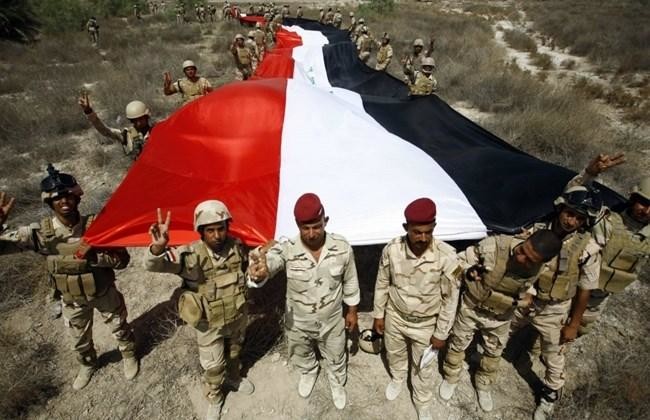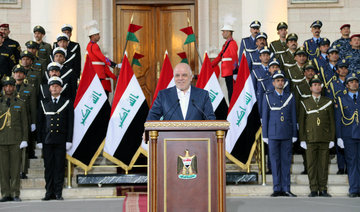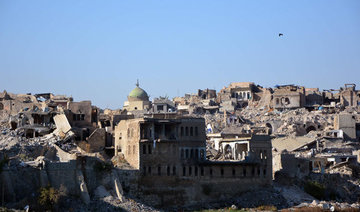This year was a much better one for Iraqis, who have suffered severe security, economic and political conditions during the past three years after Daesh militants overran the northern and western parts of the country and seized almost a third of its territories, killing tens of thousands of people and displacing millions.
All this was accompanied by a quasi-bankrupt treasury and a drain on the country’s financial and human resources because of the war on the militants, but the situation is much improved and Iraq has finally come out of the “neck of the bottle,” according to analysts.
“It is certainly a year of achievements and an end to most of the crises that have strangled Iraq over the past years,” Abdulwahid Tuama, a political analyst told Arab News.
“Liberating the Iraqi territories, ending the war against Daesh, lifting the long-term economic sanctions imposed on Iraq, the rise in oil prices and the significant improvement of the Iraqi-regional relationship are all major breakthroughs achieved in 2017,” Tuama said.
Iraqi Prime Minister Haider Abadi on Dec. 9 declared the end of the three-year-long war against Daesh and the liberation of the Iraqi territories. A day earlier, the UN Security Council unanimously voted on Iraq’s exit from Chapter VII and ended 26 years of economic sanctions imposed on the country since Iraq invaded Kuwait in 1991.
The battle to liberate Mosul, the largest populated Iraqi city-seized by Daesh, was the fiercest, the biggest and the longest in the campaign waged by Iraqi forces and its backers against the radical organization.
More than 100 000 Iraqi troops, backed by US-led military coalition air forces and the Shiite-dominated Popular Mobilization troops, fought for almost nine months to regain control of the city, which included the most important and largest strongholds of the militants, the headquarters of control and command and the biggest weapons depots of the organization in Iraq.
By the end of the battle on Feb. 19, more than 25,000 militants had been killed, military officers said.
“The battle to retake Mosul is the most important one, because it broke the backbone of the organization and completely paralyzed it (Daesh) and ended its military capacity,” Retired Gen. Emad Allow, a EU adviser on terrorism, told Arab News.
“This battle also witnessed a significant development in the combat skills of the Iraqi security forces, as the fighting was fierce and house-to-house because of the nature of the city,” Allow said.
Baghdad has been immersed in its war against terrorism in recent years. This has encouraged the regional government of the Kurdish region, semi-autonomous since the 1970s, to extend its control over the disputed areas which lie outside the 2003-constitutionally approved part of the region.
The northern oil hub city of Kirkuk and its lucrative oil fields are at the core of the disputed areas between Baghdad and Kurdistan since 2003. The Kurdistan regional government held a controversial referendum on independence in late September.
“Holding the referendum (on independence) was like an earthquake that hit the political process in Iraq. It was no less a force in its impact than the (2014) fall of the three provinces into the hands of Daesh,” political analyst Joma’ah Al-A’atoani told Arab News.
“Actually it (the referendum) was even more dangerous because, under the umbrella of national slogans calling for freedom of self-determination, Iraq almost entered a dark corner and it paved the way to cut off a large area of its territory,” A’atoani said.
Baghdad has responded by launching a huge military campaign to drive the Kurdish forces out of Kirkuk, its oil fields and most of the disputed areas. It has imposed a series of punitive measures on the region, including the banning of international flights to and from airports and the closing down of border crossings with Turkey and Iran.
“Gaining back control over the disputed areas and oil fields, shutting down the airports and crossing borders in the region is a major achievement and proved that the Iraqi government is capable of confronting anything that threatens the unity of the country and affects its sovereignty,” A’atoani said.
The year was not limited to military and political achievements. The policy of non-interference in the affairs of other countries in the region, which Abadi has adopted since he became prime minister, has also begun to bear fruit.
The Iraqi-regional relationship has significantly improved in 2017. Abadi has made several regional and international rounds during the past two months, culminating in the signing of several economic, security and military agreements with Turkey, France, Iran, Jordan and other countries.
The most important breakthrough for Iraqis was the improvement of relations between Baghdad and Riyadh, which had been fluctuating for the past three decades.
In February this year, Saudi Foreign Minister Adel Al-Jubeir was the first senior Saudi official to visit Baghdad since 2003.
Al-Jubeir’s visit was followed by a visit from Abadi to Saudi Arabia in June and another one in October to end the boycott between the two countries.
The visits opened the door for the countries to exchange visits and sign joint agreements, particularly in the oil, reconstruction, transport and anti-terrorism sectors. Last month, Saudi Arabia appointed Abdul Aziz Al-Shimari as the new ambassador to Iraq.
“Saudi-Iraqi rapprochement will ease the sectarian strife inside Iraq and deprive the Iraqi rival parties of playing the sectarian card,” Abdulwahid Tuama said.
“Also, it (rapprochement) will bring much economic gain to both countries. Iraq is looking to reach the ports of the Red Sea to export its oil, in return it can offer significant investment opportunities for Saudi companies and goods in many areas and sectors,” Tuama said.


Iraq ‘out of neck of the bottle’ by end of 2017: political analysts
Iraq ‘out of neck of the bottle’ by end of 2017: political analysts

Thousands stage pro-Gaza rally in Istanbul

- Thousands joined a New Year’s Day rally for Gaza in Istanbul Thursday, waving Palestinian and Turkish flags and calling for an end to the violence in the tiny war-torn territory
ISTANBUL: Thousands joined a New Year’s Day rally for Gaza in Istanbul Thursday, waving Palestinian and Turkish flags and calling for an end to the violence in the tiny war-torn territory.
Demonstrators gathered in freezing temperatures under cloudless blue skies to march to the city’s Galata Bridge for a rally under the slogan: “We won’t remain silent, we won’t forget Palestine,” an AFP reporter at the scene said.
More than 400 civil society organizations were present at the rally, one of whose organizers was Bilal Erdogan, the youngest son of Turkish President Recep Tayyip Erdogan.
Police sources and Anadolou state news agency said some 500,000 people had joined the march at which there were speeches and a performance by Lebanese-born singer Maher Zain of his song “Free Palestine.”
“We are praying that 2026 will bring goodness for our entire nation and for the oppressed Palestinians,” said Erdogan, who chairs the board of the Ilim Yayma Foundation, an educational charity that was one of the organizers of the march.
Turkiye has been one of the most vocal critics of the war in Gaza and helped broker a recent ceasefire that halted the deadly war waged by Israel in response to Hamas’s unprecedented attack on October 7, 2023.
But the fragile October 10 ceasefire has not stopped the violence with more than more than 400 Palestinians killed since it took hold.
Demonstrators gathered in freezing temperatures under cloudless blue skies to march to the city’s Galata Bridge for a rally under the slogan: “We won’t remain silent, we won’t forget Palestine,” an AFP reporter at the scene said.
More than 400 civil society organizations were present at the rally, one of whose organizers was Bilal Erdogan, the youngest son of Turkish President Recep Tayyip Erdogan.
Police sources and Anadolou state news agency said some 500,000 people had joined the march at which there were speeches and a performance by Lebanese-born singer Maher Zain of his song “Free Palestine.”
“We are praying that 2026 will bring goodness for our entire nation and for the oppressed Palestinians,” said Erdogan, who chairs the board of the Ilim Yayma Foundation, an educational charity that was one of the organizers of the march.
Turkiye has been one of the most vocal critics of the war in Gaza and helped broker a recent ceasefire that halted the deadly war waged by Israel in response to Hamas’s unprecedented attack on October 7, 2023.
But the fragile October 10 ceasefire has not stopped the violence with more than more than 400 Palestinians killed since it took hold.
© 2026 SAUDI RESEARCH & PUBLISHING COMPANY, All Rights Reserved And subject to Terms of Use Agreement.












